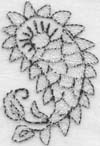Section 10 == *script chart*; *positional chart*; *more help*
The greatest thing that is more convenient and efficient in Urdu than in Devanagari is aspiration; the second greatest is nasalization, discussed in section 9. The moment you realize the beauty of Urdu-style aspiration, you wonder why the Indic scripts never got around to inventing it. You simply have a small portable aspirator, and you carry it around and plug it in to whatever consonant you want to aspirate-- and behold, a lot fewer letters to memorize! The aspirator in Urdu is called do-chashmī he , "two-eyed he." It indeed looks two-eyed, or rather almost like a divided heart-shape. Nowadays, the convention of reserving do-chashmī he for cases of aspiration is very well established.
Sometimes, however, do-chashmī he is treated as a variant form of chhoṭī he . This is done either in typewritten or some computer-generated scripts, for simplicity; or in older texts, often for variety or for calligraphic decoration. You'll often see the word hai written with do-chashmī he in older texts, apparently as a kind of artistic flourish.
Remember that since systematic aspiration (apart from the "sh" of shīn ) exists only in Urdu, and not at all in Arabic or Persian, only Urdu has needed to distinguish do-chashmī he from chhoṭī he in the first place, in order to set the former aside as an aspirator. So if there is some blurring of boundaries between the two forms, it's not surprising. As always, the real way you can be sure is by knowing, recognizing, or deducing the word in question: bahār (springtime) is quite different from bhār (burden).
In metrical terms, do-chashmī he is invisible, and doesn't count as a letter at all. For discussion of the metrical system used in classical Urdu poetry see *Urdu Meter: a Practical Handbook*.
Since aspiration-based consonant distinctions are so fundamental to the sound system of Urdu/Hindi, and so alien to the sound system of English, it might be useful to say a little about them. In saying our English consonants, we aspirate all over the place, especially in letters like "p." Just say it, with your palm in front of your mouth, and feel that little puff of air. But it doesn't matter, because there are no contrasts to be made, so a little air more or less is of no importance at all. In Urdu, by contrast, the presence or absence of that puff of air is the single differentiating mark between a great many pairs of consonants, so in native speakers it's very much under control, and unless it needs to be present, it's strictly absent.
This is why Urdu speakers have such crisp-sounding consonants, even when speaking English. (It sounds lovely to me; it was one of the first things I enjoyed about hearing the language.) Try listening carefully to your native-speaker friends when they speak English, and hear how those sharp, crisp consonants are entirely stripped of air, and emerge so cleanly. Sometimes a "p" can almost sound like a "b," because our ears are so little tuned to un-aspiration that we hear such a sound as voiced. It's a way you can develop your ear for the sounds of the language, even when you're speaking English.
A great way to practice is to go off by yourself and hold your palm in front of your lips and try to say "p" in such a way that no puff of air emerges. You'll end up using just your lips. It can be done, and it's fun.
This kind of practice will also help you avoid over-aspirating. Sometimes students get so determined to aspirate that they tend to add in a whole extra syllable-- over the years I've heard a lot of explosive renderings: "bha-HII" instead of bhī . Since the unaspirated consonant is really so naked and air-free, a modest amount of air is all that's needed to differentiate the aspirated form, and it never sounds anything like a separate syllable.
If it takes a while to get proficient in pronunciation, don't despair. Just think of the trouble your native-speaker friends probably have in differentiating between "v" and "w." Over the years I've also heard a lot of exasperated North Indians and Pakistanis exclaim, "That's what I said-- woice!" (And don't even think of getting them started on "vowel.")
Apart from moral support, listening closely to how Hindi/Urdu speakers pronounce English words gives you clues to where they're from and what their background might be. It's conspicuous to an Urdu-speaker that the farther east you go, the greater the uncertainty of the sounds: "j" and "z" tend to oscillate back and forth quite independently of their proper placement. (I still remember how puzzled I was when I first arrived in India and people told me I mustn't fail to see the "Calcutta Jew.") Sometimes they create a kind of attempted hyper-correctness: you often hear rivāz for rivāj , "custom." (This always reminds me of how American newscasters all taught each other to say "Razheev" Gandhi, since apparently rājīv didn't sound exotic enough.) In addition, easterners tend to collapse "sh" into "s," and they're often unable to pronounce ġhain (they substitute gh ) and ḳhe (they substitute kh ).
Of course, all the enjoyable subtleties of Sanskritized Hindi pronunciation (and orthography) tend similarly to get lost in Urdu script and pronunciation. Mostly it's only us outsiders who really aspire to be fully conversant with the whole range of khaṛī bolī speech and writing. (Along the same lines, I'm the only person I know who can sing both the Pakistani and the Indian national anthems-- not to mention all the verses of the American one.)
There's a lot more to be said about pronunciation, when I get around to it.
